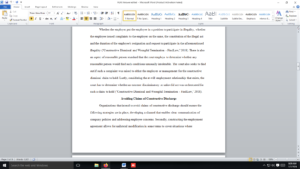Employee terminations
Overview
To be wrongfully terminated is to be fired for an illegal reason, which may involve violation of federal antidiscrimination laws or breach of contract. The legal standards governing termination differ substantially depending on whether private-sector and nonunion employees or public-sector and unionized employees are being considered. As the company HR leader, you are accountable to the organization to ensure that all employee terminations are initiated and completed while maintaining strict adherence to current employment laws and EEOC guidelines.
Instructions
Write a 5–6 page paper in which you:
- Address your understanding of the term constructive discharge—what is it? Then, identify factors courts might focus on to determine if constructive discharge exists. How might the organization avoid claims of constructive discharge? Hint: Read Constructive Dismissal and Wrongful Termination.
- Discuss the differences between pure employment at will and employment at will with exceptions. Do you believe employment at will is fair? If not, what is an alternative?
- Briefly describe what the Montana Wrongful Discharge from Employment Act (WDEA) is. What do you see as benefits of this act to employees? Employers?
- Identify and discuss a minimum of three actions organizations may want to consider as they seek to handle employee terminations legally.
- Go to Basic Search: Strayer University Online Library to locate at least three quality academic resources in this assignment. Note: Wikipedia and other websites do not qualify as academic resources.
Requirements: 5-6 pages | .doc file
Answer preview
The Montana Wrongful Discharge from Employment Act (WDEA) was enacted in 1987 by the state of Montana to effect some changes in the employment-at-will rule. Among all the states in the U.S., the statutory modification on the employment-at-will rule has been effected by Montana. The act serves to uphold the employment-at-will rule while at the same time introducing some modifications on the legal grounds for claims on wrongful termination. The act provides that termination can only be wrongful under the following situations. Firstly, a termination is wrongful under the act if an employee is dismissed for refusing to breach public policy or reports instances of public policy violation. Secondly, discharge can be considered wrongful when an employer overturns any form of a written agreement on the policy (Hijal-Moghrabi et al., 2017). Lastly, a wrongful discharge results when an employee who has completed their probationary period is terminated without proper cause.
[1927 Words]

Employee terminations

